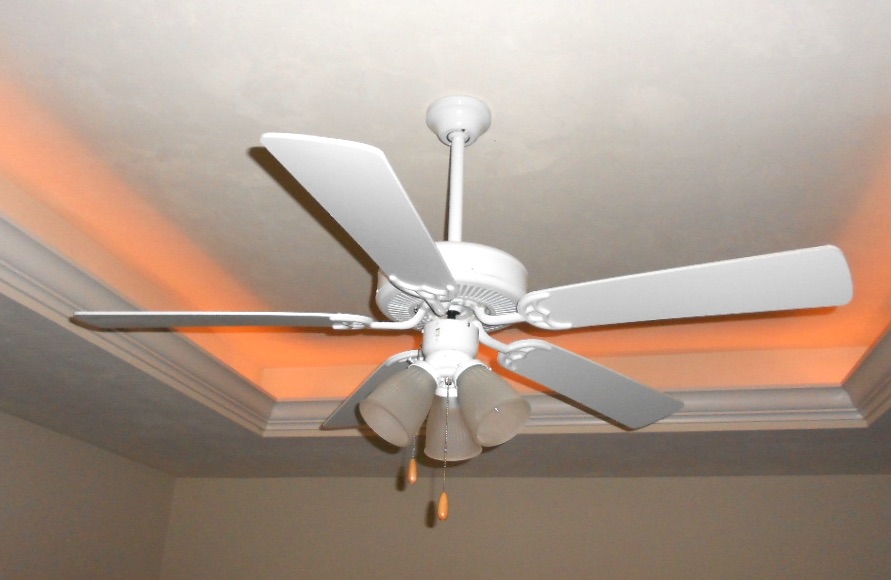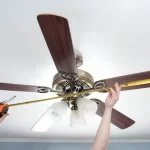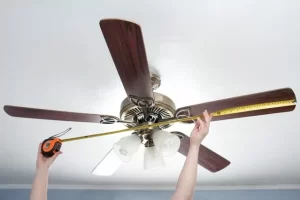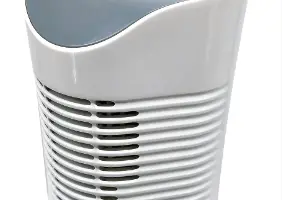Ceiling fans are a popular choice for maintaining a comfortable indoor environment while reducing energy consumption. However, determining the ideal height for a ceiling fan from the ground is crucial for maximizing its performance and ensuring user comfort.
Contents
We recently got a ceiling fan installed in our house which has a height of 9 feet. It is then that we studied the rules and considerations of optimal height upto which ceiling fan can be installed. In this article, we will explore the factors that influence the height of a ceiling fan, providing you with insights to help you make an informed decision.

How High Should a Ceiling Fan be Off the Ground? – Understanding Optimal Height
Following are the most important considerations to know the optimal height of the ceiling fan from the ground:
Blade Clearance Factor:
When it comes to installing a ceiling fan, one of the primary considerations is the clearance between the fan blades and the floor. It is essential to maintain an appropriate height to prevent any potential safety hazards and to facilitate proper air circulation. As a general guideline from National Building Code, a minimum clearance of 7 and 1/2 feet (90 inches) between the floor and the fan blades is recommended.
Consider Ceiling Height:
In addition to the blade clearance factor, it is crucial to consider the height of your ceiling. Different ceiling heights will require varying fan mounting options to ensure optimal airflow and overall effectiveness. Let’s explore the recommended mounting options based on common ceiling heights:
- Standard Ceiling Height (8-9 feet):
For rooms with standard ceiling heights, typically ranging from 8 to 9 feet, the most common ceiling fan mounting option is flush or hugger mounting. These types of installations position the fan close to the ceiling, allowing for efficient air circulation without compromising headroom. Flush-mounted fans are especially suitable for low-ceiling areas such as bedrooms, hallways, and smaller living spaces.
- High Ceiling (10 feet or higher):
If you have a high ceiling measuring 10 feet or higher, it is advisable to install an extended downrod to lower the fan and improve its performance. Downrods are typically available in various lengths and can be customized to suit your specific needs. The extension provided by the downrod allows the fan to operate at an ideal height, ensuring proper air movement throughout the room. This mounting option is particularly effective in spacious areas like great rooms or open-concept living spaces.
Other Factors to Consider to Determine Height
Other than the above there are few other things to keep in mind while installing a ceiling fan:
How Can You Maximize Efficiency and Comfort with Ceiling Fan?
In certain ways you can ensure to maximize efficiency and comfort with ceiling fan. Following are a few of them:
- Balancing Airflow and Noise
While installing a ceiling fan at the optimal height is crucial for comfort, it is equally important to balance the airflow and noise produced by the fan. Improper installation or incorrect blade height can result in uneven airflow patterns and unnecessary noise. To achieve an optimal balance, follow the manufacturer’s instructions and ensure that the fan blades are positioned at a consistent height from the ground.
- Combining Ceiling Fans with Other Cooling Systems
Ceiling fans can be used in conjunction with other cooling systems, such as air conditioners or evaporative coolers, to enhance their efficiency. By strategically placing ceiling fans in rooms with AC or other cooling systems, you can achieve a more even distribution of cooled air and reduce the reliance on the cooling system alone. This combination allows you to set your air conditioner at a higher temperature, saving energy and reducing utility costs while maintaining a comfortable environment.
- Adjusting Fan Speed and Direction
Most ceiling fans come with multiple speed settings and the ability to change the direction of the blades. During the warmer months, running the fan counterclockwise creates a cooling breeze effect by pushing air downward. In the colder months, running the fan in a clockwise direction at a low speed helps to redistribute warm air trapped near the ceiling back down into the room. Adjusting the fan speed and direction according to the season and your comfort needs can further optimize the efficiency and effectiveness of your ceiling fan.
Safety Considerations While Determing Right Height for Ceiling Fan
Installation of ceiling fan at the optimum height also has some safety considerations. Let us see them below:
Conclusion:
Selecting the ideal height for a ceiling fan is essential for maximizing its performance, improving comfort levels, and optimizing energy efficiency. By considering factors such as blade clearance, ceiling height, ceiling slope, fan size, and the use of other cooling systems, you can make an informed decision about the height of your ceiling fan installation. Remember to prioritize safety, balance airflow and noise, and consider maintenance requirements for a seamless and enjoyable experience with your ceiling fan.










Add Comment